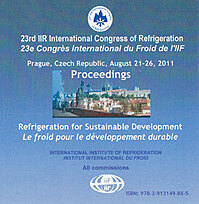
Document IIF
Performance d'un cycle à absorption à double effet par transport de solution pour utiliser la chaleur de condensation lors de la génération d'électricité à partir de déchets.
Performance of double effect solution transportation absorption cycle to utilize condensation heat of refuse power generation.
Numéro : pap. ID: 739
Auteurs : AKISAWA A., MORI S., UEDA Y., et al.
Résumé
The authors proposed heat transportation system based on ammonia absorption refrigeration cycle named STA. The idea is to transport ammonia solutions instead of chilled water from heat source side to heat demand side. It can transport thermal energy at ambient temperature because the system converts thermal energy into concentration difference of the solutions. However, because the COP of the ammonia based STA is not high enough, combination of LiBr absorption cycle to enhance the performance was proposed so that the COP could be doubled. The objective of the paper is to investigate the performance of the double effect STA to supply cooling. It was also attempted to apply the double effect STA to refuse power generation to utilize condensation heat to drive STA. The total performance of power generation and cooling supply was discussed in terms of primary energy reduction.
Documents disponibles
Format PDF
Pages : 7 p.
Disponible
Prix public
20 €
Prix membre*
Gratuit
* meilleur tarif applicable selon le type d'adhésion (voir le détail des avantages des adhésions individuelles et collectives)
Détails
- Titre original : Performance of double effect solution transportation absorption cycle to utilize condensation heat of refuse power generation.
- Identifiant de la fiche : 30002178
- Langues : Anglais
- Source : Proceedings of the 23rd IIR International Congress of Refrigeration: Prague, Czech Republic, August 21-26, 2011. Overarching theme: Refrigeration for Sustainable Development.
- Date d'édition : 21/08/2011
Liens
Voir d'autres communications du même compte rendu (569)
Voir le compte rendu de la conférence
Indexation
-
A comparison between lithium bromide-water and ...
- Auteurs : RÖMICH C., MERKEL N., SCHABER K., et al.
- Date : 21/08/2011
- Langues : Anglais
- Source : Proceedings of the 23rd IIR International Congress of Refrigeration: Prague, Czech Republic, August 21-26, 2011. Overarching theme: Refrigeration for Sustainable Development.
- Formats : PDF
Voir la fiche
-
Optimum performance of external intercooling tw...
- Auteurs : MARTÍNEZ-BALLESTER S., GONZÁLVEZ-MACIÁ J., CORBERÁN J. M.
- Date : 21/08/2011
- Langues : Anglais
- Source : Proceedings of the 23rd IIR International Congress of Refrigeration: Prague, Czech Republic, August 21-26, 2011. Overarching theme: Refrigeration for Sustainable Development.
- Formats : PDF
Voir la fiche
-
Interest of ammonia-water absorption chiller to...
- Auteurs : TAUVERON N., BOUDÉHENN F., POUVREAU J., et al.
- Date : 18/06/2018
- Langues : Anglais
- Source : 13th IIR Gustav Lorentzen Conference on Natural Refrigerants (GL2018). Proceedings. Valencia, Spain, June 18-20th 2018.
- Formats : PDF
Voir la fiche
-
Novel microemulsion absorption cooling cycle.
- Auteurs : HWANG Y., RADERMACHER R., YANG B.
- Date : 07/08/2017
- Langues : Anglais
- Source : International sorption heat pump conference, ISHPC 2017, Tokyo august 7-10.
Voir la fiche
-
Influence of atmospheric air conditions and inl...
- Auteurs : GUIRARDI W., PEIXOTO R. A.
- Date : 21/08/2011
- Langues : Anglais
- Source : Proceedings of the 23rd IIR International Congress of Refrigeration: Prague, Czech Republic, August 21-26, 2011. Overarching theme: Refrigeration for Sustainable Development.
- Formats : PDF
Voir la fiche
